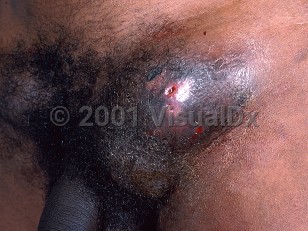Lymphogranuloma venereum - Anogenital in
See also in: Overview,Cellulitis DDxAlerts and Notices
Important News & Links
Synopsis

Lymphogranuloma venereum (LGV) is an uncommon sexually transmitted infection (STI) caused by the obligate intracellular bacteria Chlamydia trachomatis (serovars L1, L2, or L3). It is worldwide in distribution, but more commonly seen in tropical and subtropical countries. It can present with genital ulcerative disease, lymphadenopathy, or proctocolitis. There are also reports of asymptomatic infection.
There are 3 distinct stages in the course of the disease.
Stage 1:
After a 3- to 30-day incubation period, a small, painless papule or pustule develops on the genital area. Most often, it will erode and ulcerate. This lesion is often asymptomatic and heals without scarring within 1 week. Some patients may be unaware of this occurrence.
Stage 2:
The second or inguinal stage begins 2-6 weeks after the primary lesion. It signifies the spread of the organism from the primary lesion into the lymph nodes and presents as inguinal buboes (painful inflammation of the inguinal lymph nodes), which become fluctuant and rupture. Symptoms include general weakness, headache, and weight loss. It is usually during this stage that patients seek medical help.
Stage 3:
The third stage of LGV is elephantiasis of the penis and scrotum. This swelling is caused by fibrosis with occlusion of the lymphatics, which impedes lymphatic return. Genito-anorectal syndrome can also be seen in the third stage, but usually only in men who have sex with men or in women. These patients initially present with proctocolitis, followed by perirectal abscesses, strictures, fistulas, and rectal stenosis.
There are 3 distinct stages in the course of the disease.
Stage 1:
After a 3- to 30-day incubation period, a small, painless papule or pustule develops on the genital area. Most often, it will erode and ulcerate. This lesion is often asymptomatic and heals without scarring within 1 week. Some patients may be unaware of this occurrence.
Stage 2:
The second or inguinal stage begins 2-6 weeks after the primary lesion. It signifies the spread of the organism from the primary lesion into the lymph nodes and presents as inguinal buboes (painful inflammation of the inguinal lymph nodes), which become fluctuant and rupture. Symptoms include general weakness, headache, and weight loss. It is usually during this stage that patients seek medical help.
Stage 3:
The third stage of LGV is elephantiasis of the penis and scrotum. This swelling is caused by fibrosis with occlusion of the lymphatics, which impedes lymphatic return. Genito-anorectal syndrome can also be seen in the third stage, but usually only in men who have sex with men or in women. These patients initially present with proctocolitis, followed by perirectal abscesses, strictures, fistulas, and rectal stenosis.
Codes
ICD10CM:
A55 – Chlamydial lymphogranuloma (venereum)
SNOMEDCT:
186946009 – Lymphogranuloma Venereum
A55 – Chlamydial lymphogranuloma (venereum)
SNOMEDCT:
186946009 – Lymphogranuloma Venereum
Look For
Subscription Required
Diagnostic Pearls
Subscription Required
Differential Diagnosis & Pitfalls

To perform a comparison, select diagnoses from the classic differential
Subscription Required
Best Tests
Subscription Required
Management Pearls
Subscription Required
Therapy
Subscription Required
References
Subscription Required
Last Reviewed:11/09/2021
Last Updated:11/22/2021
Last Updated:11/22/2021
 Patient Information for Lymphogranuloma venereum - Anogenital in
Patient Information for Lymphogranuloma venereum - Anogenital in
Premium Feature
VisualDx Patient Handouts
Available in the Elite package
- Improve treatment compliance
- Reduce after-hours questions
- Increase patient engagement and satisfaction
- Written in clear, easy-to-understand language. No confusing jargon.
- Available in English and Spanish
- Print out or email directly to your patient
Upgrade Today

Lymphogranuloma venereum - Anogenital in
See also in: Overview,Cellulitis DDx

